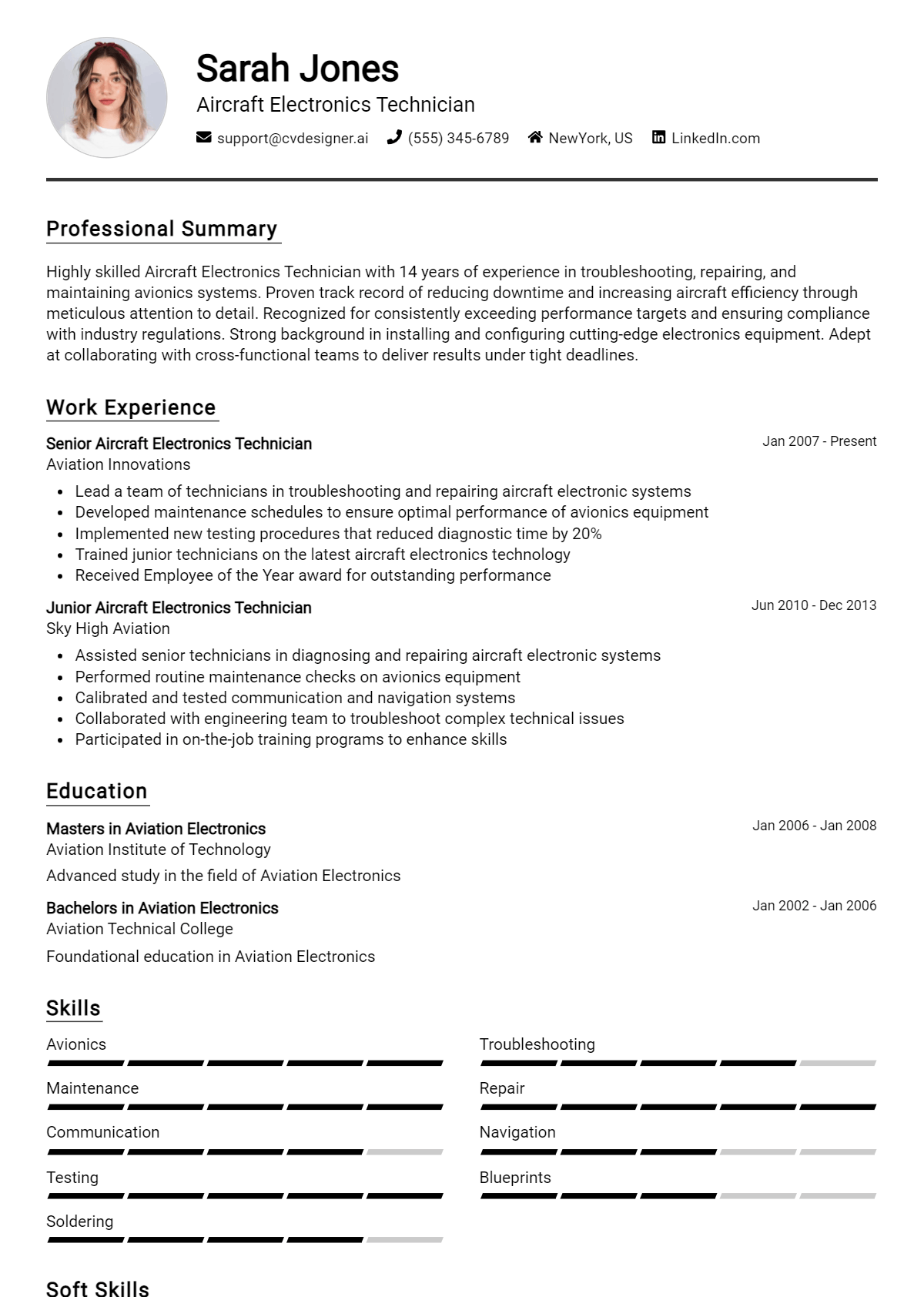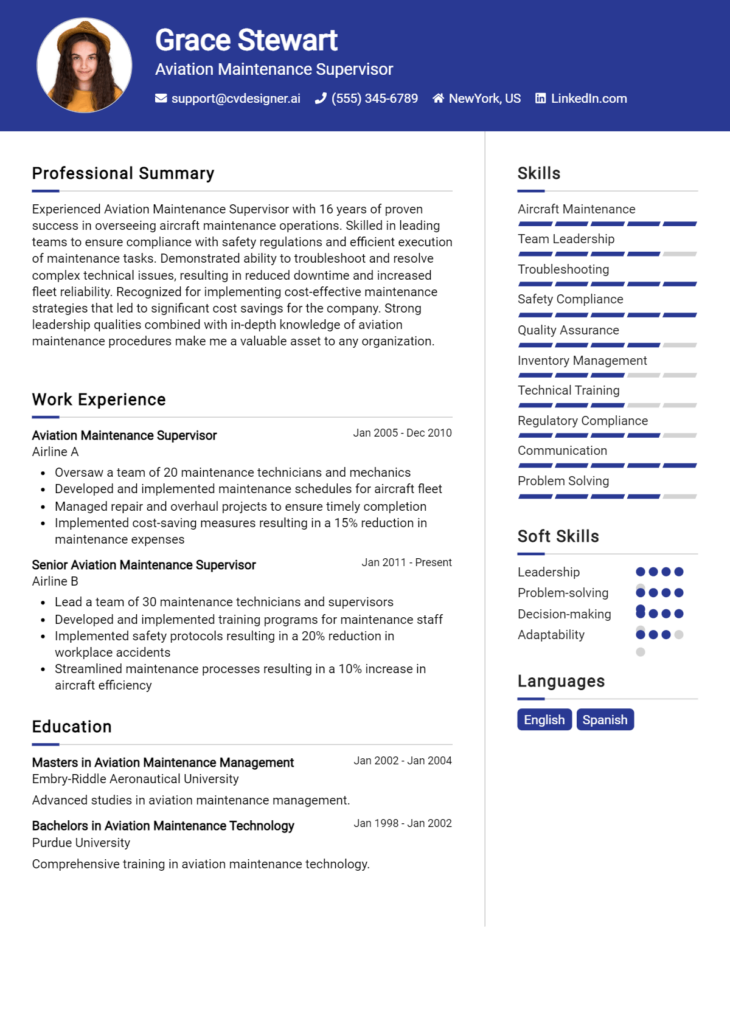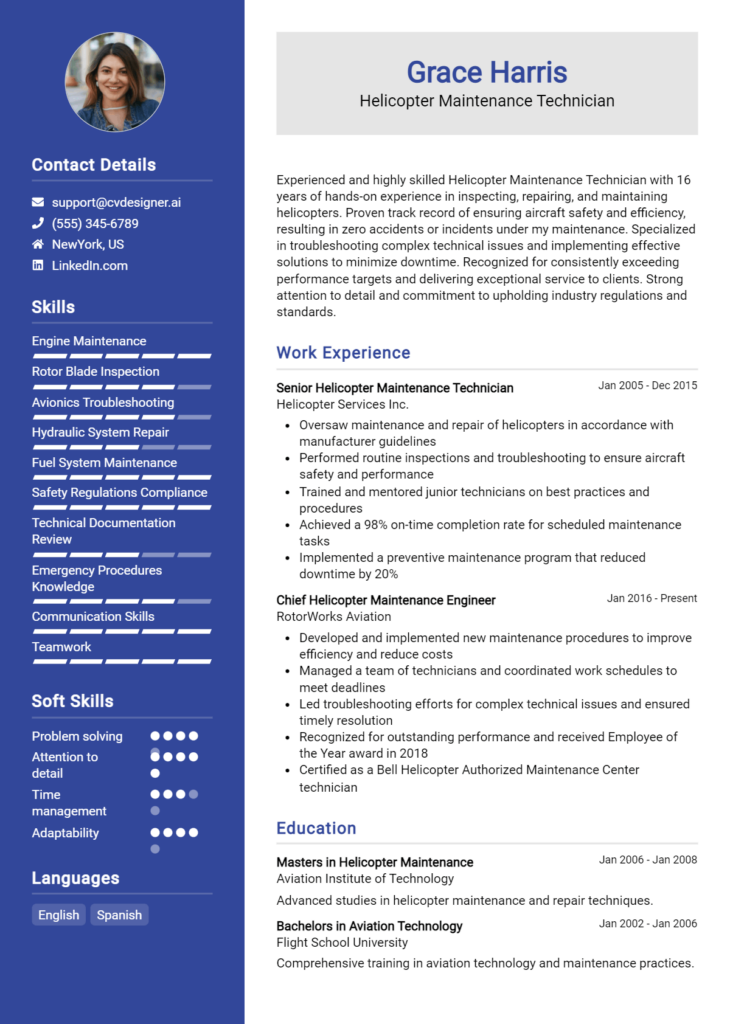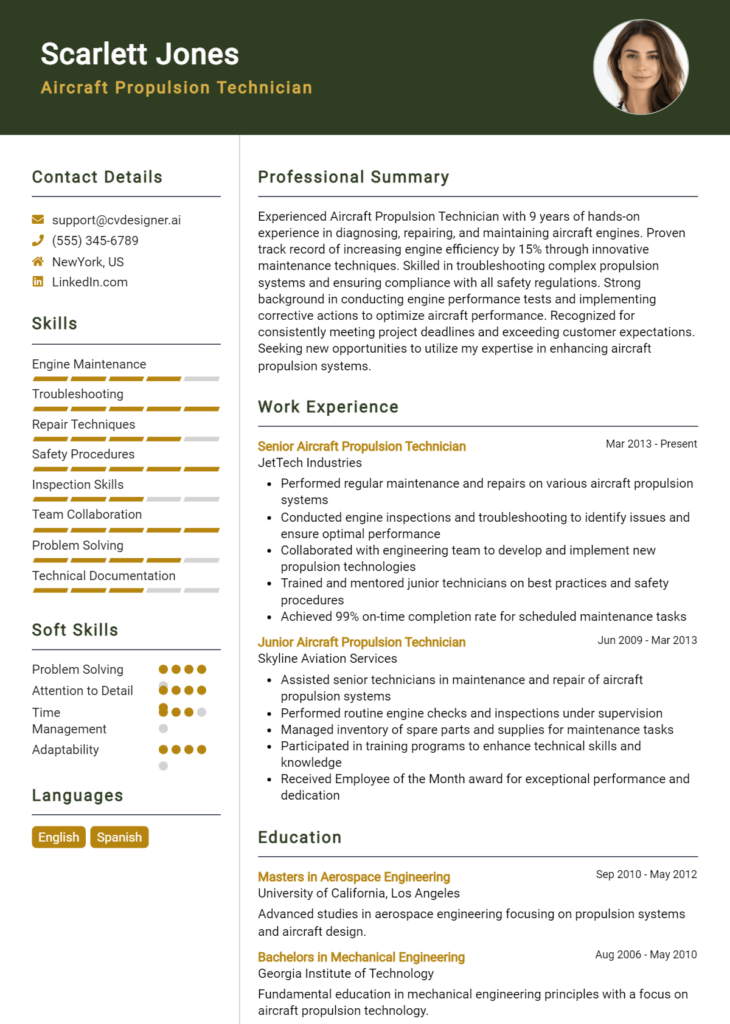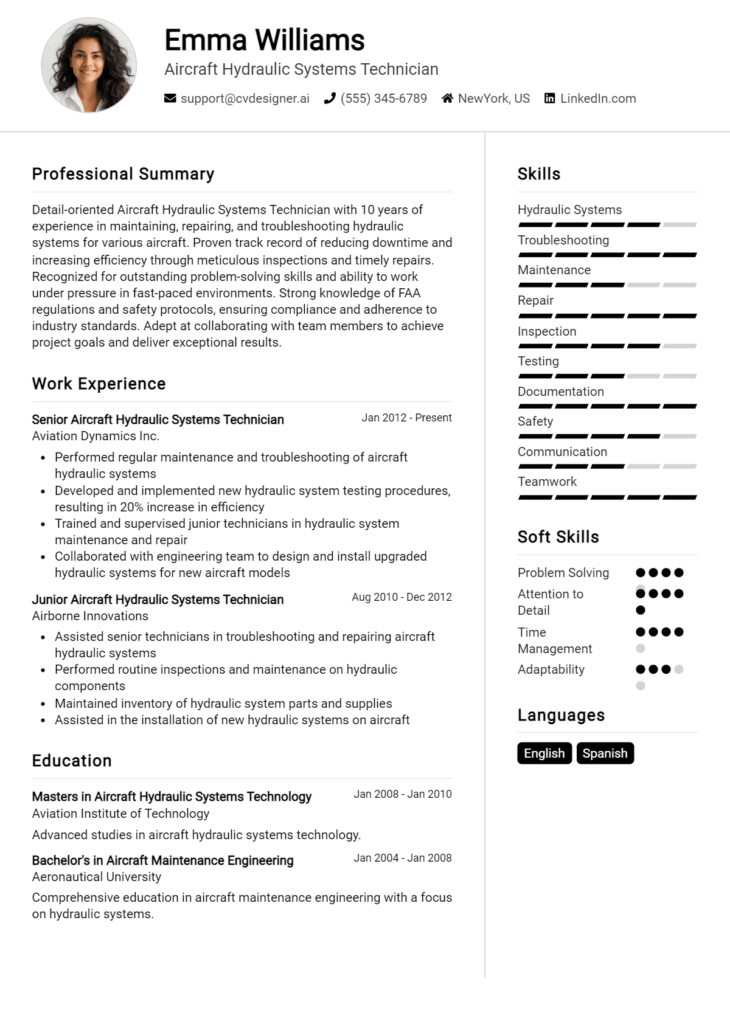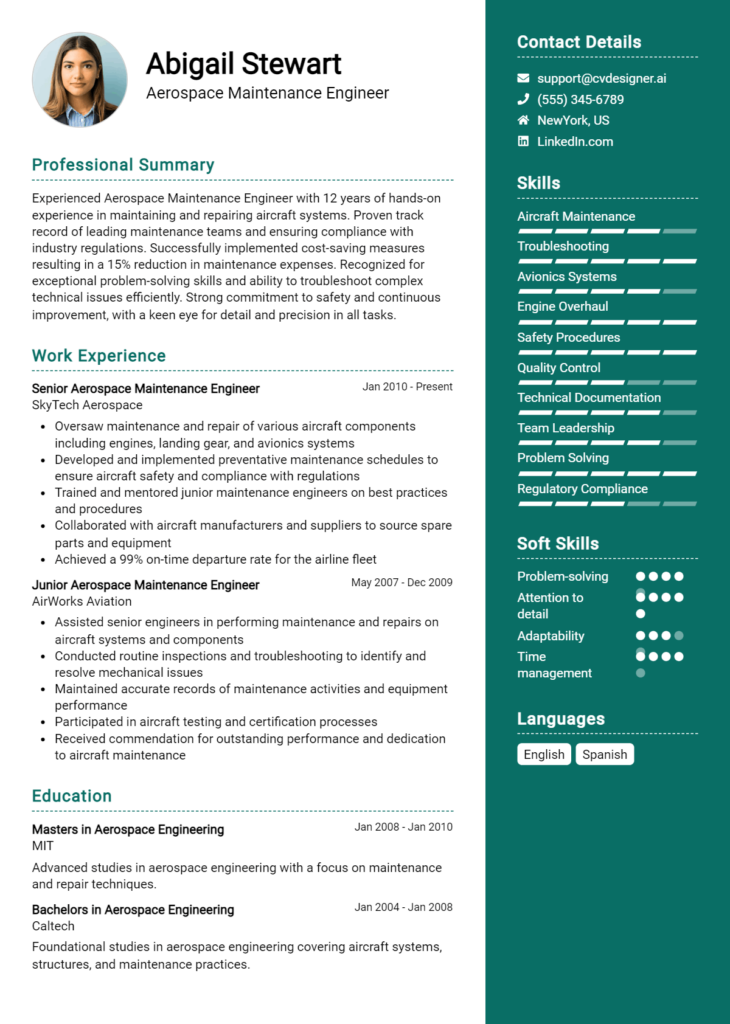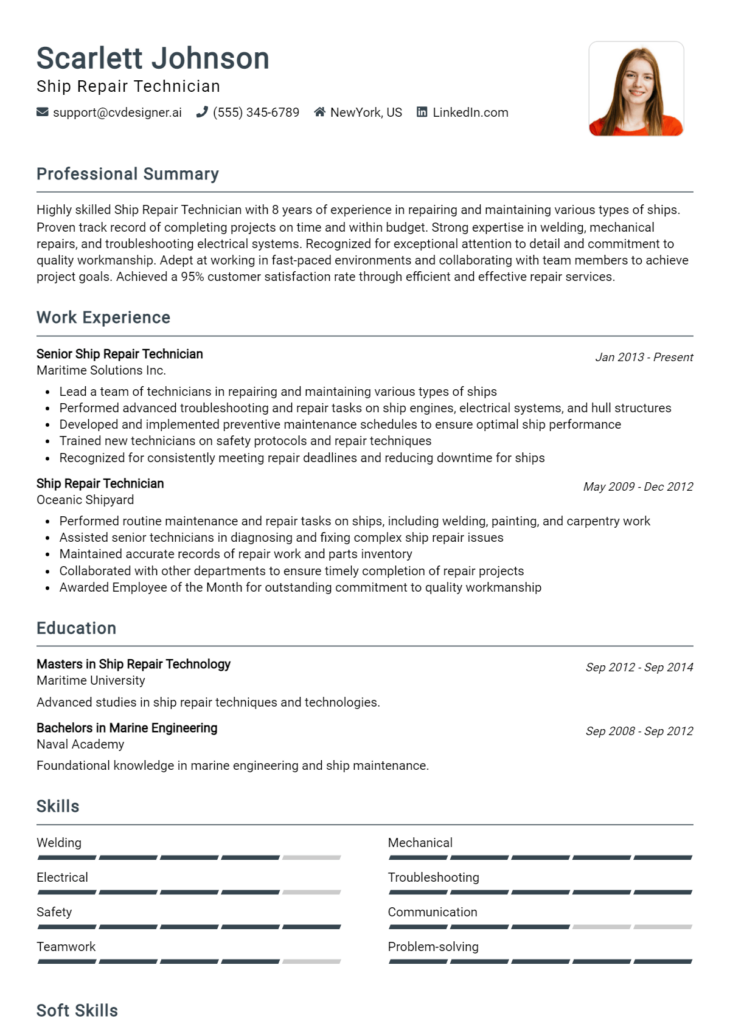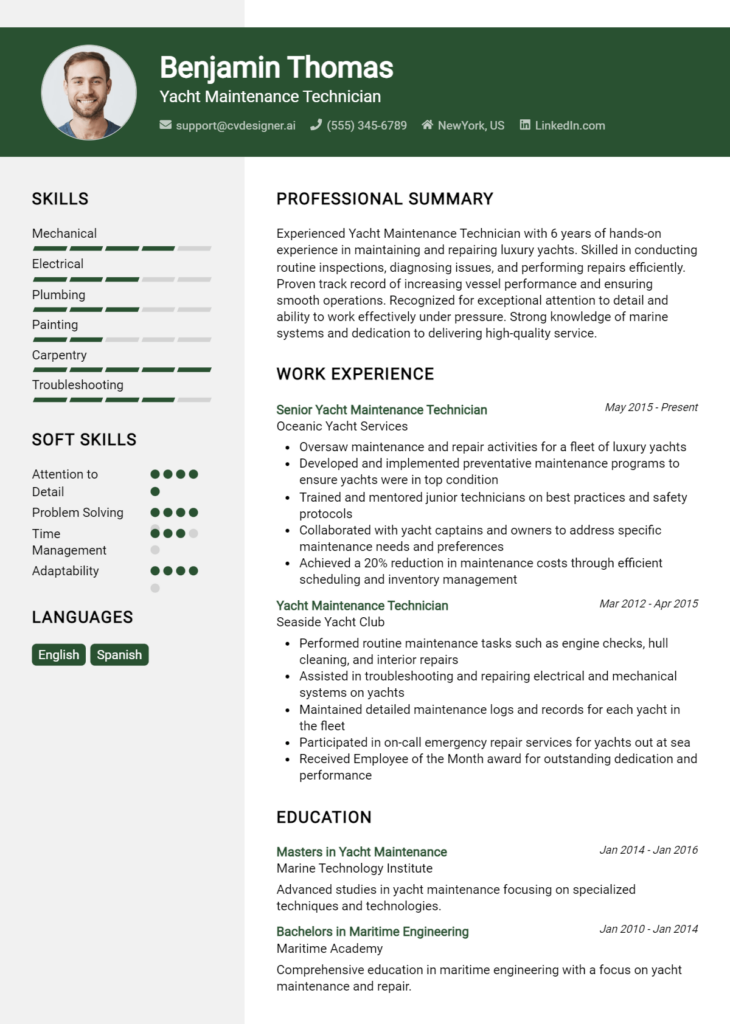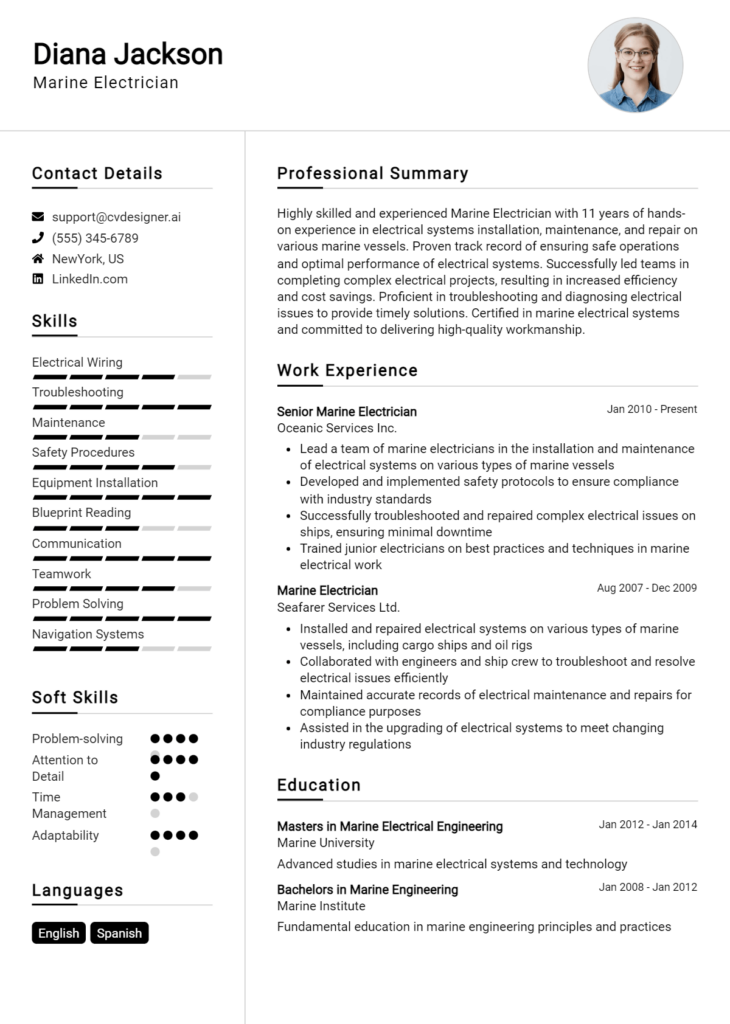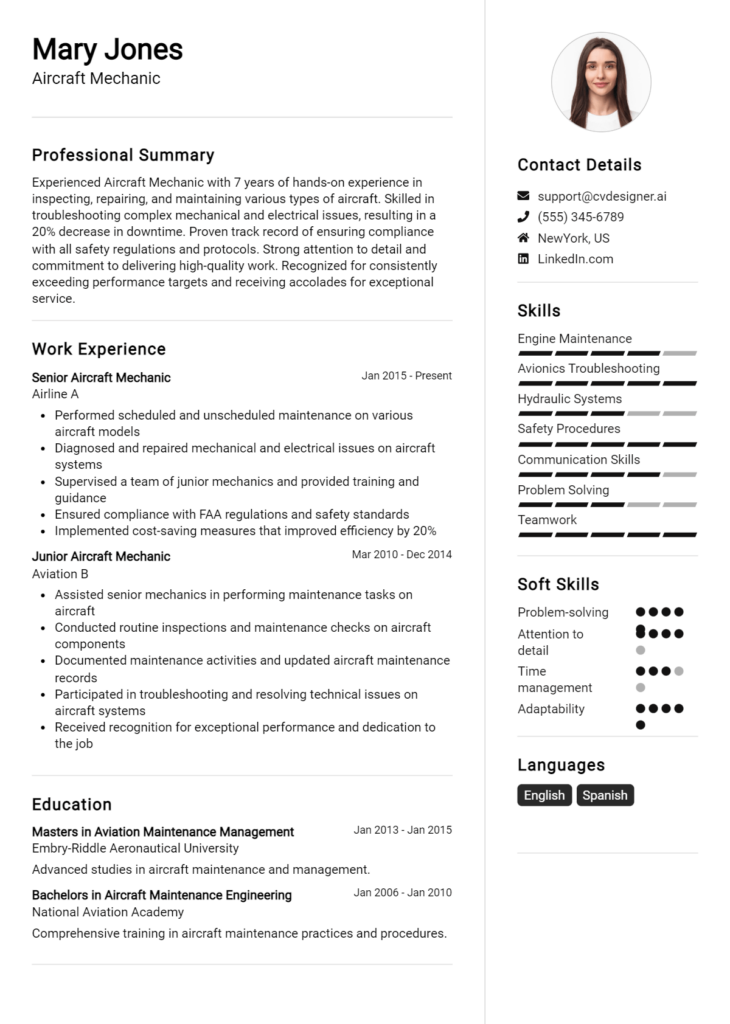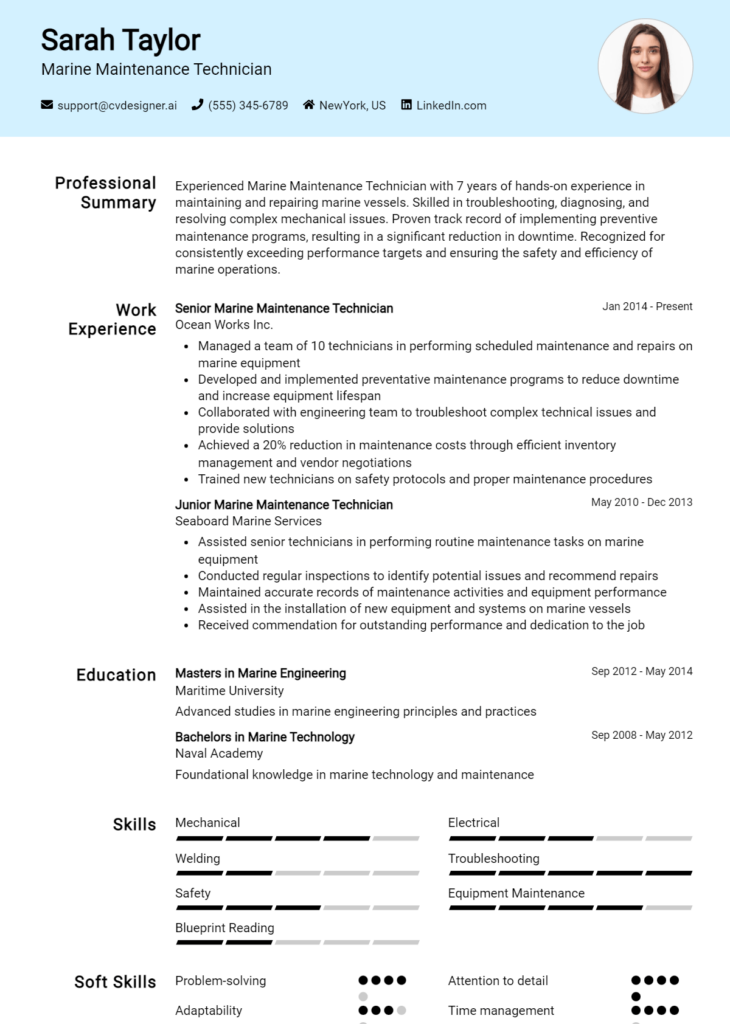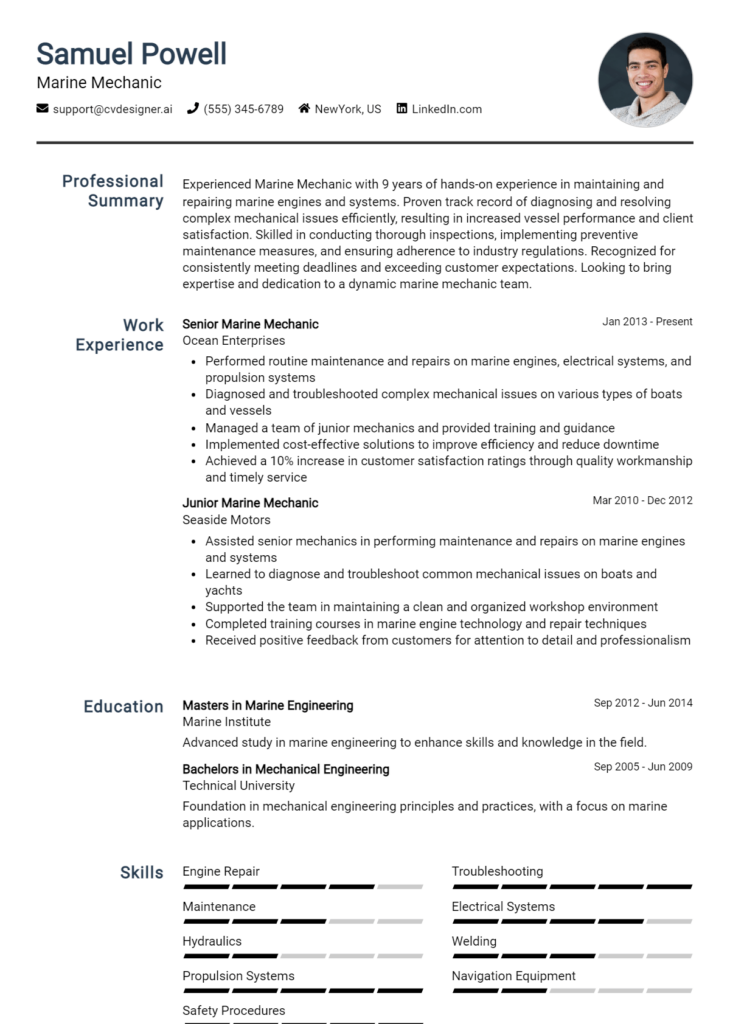Aircraft Electronics Technician Core Responsibilities
An Aircraft Electronics Technician plays a crucial role by ensuring the reliability and functionality of aircraft electronic systems. Key responsibilities include troubleshooting, repairing, and maintaining avionics systems, as well as collaborating with engineers and flight crews to ensure operational readiness. Essential skills encompass technical proficiency, problem-solving capabilities, and an understanding of safety regulations. These competencies are vital for enhancing organizational goals. A well-structured resume can effectively highlight these qualifications, showcasing the technician's expertise and contributions.
Common Responsibilities Listed on Aircraft Electronics Technician Resume
- Perform routine inspections and maintenance on avionics systems.
- Diagnose and troubleshoot electronic system malfunctions.
- Repair and replace faulty components and wiring.
- Conduct testing of electronic systems and equipment.
- Document repair and maintenance activities accurately.
- Ensure compliance with safety and regulatory standards.
- Collaborate with engineering teams on system upgrades.
- Assist in training and mentoring junior technicians.
- Utilize diagnostic tools and software for troubleshooting.
- Maintain inventory of electronic parts and tools.
- Support aircraft modifications and installations.
- Stay updated on advancements in avionics technology.
High-Level Resume Tips for Aircraft Electronics Technician Professionals
In the competitive world of aircraft maintenance, a well-crafted resume is crucial for Aircraft Electronics Technician professionals. It serves as the first impression a candidate makes on a potential employer, often determining whether they will advance to the interview stage. A resume must effectively reflect both technical skills and noteworthy achievements, presenting a comprehensive picture of the candidate's capabilities. This guide will provide practical and actionable resume tips specifically tailored for Aircraft Electronics Technician professionals, ensuring that your application stands out in a crowded field.
Top Resume Tips for Aircraft Electronics Technician Professionals
- Tailor your resume to the job description by incorporating keywords and phrases that match the specific requirements of the position.
- Showcase relevant experience by highlighting previous roles and responsibilities directly related to aircraft electronics maintenance and repair.
- Quantify your achievements with specific metrics, such as the number of aircraft serviced or improvements in turnaround time.
- Highlight industry-specific skills, including proficiency in avionics systems, troubleshooting techniques, and familiarity with regulatory standards.
- Include certifications and training related to aircraft electronics, as these demonstrate your commitment to professional development and compliance.
- Utilize a clean and professional format that enhances readability, ensuring that your resume is easy to scan for critical information.
- Incorporate a summary statement at the beginning to quickly convey your qualifications and career objectives.
- Emphasize teamwork and collaboration skills, as these are essential in a field where coordination with other technicians and departments is vital.
- Keep your resume concise, ideally one page, focusing on the most relevant and impactful information to maintain the reader's interest.
By implementing these tips, Aircraft Electronics Technician professionals can significantly enhance their resumes, increasing their chances of landing a job in this dynamic and rewarding field. A strong resume not only showcases your qualifications but also reflects your professionalism and attention to detail, qualities that are essential in the aviation industry.
Why Resume Headlines & Titles are Important for Aircraft Electronics Technician
The role of an Aircraft Electronics Technician is crucial in ensuring that aircraft systems function optimally and safely. In the competitive job market for aviation professionals, resume headlines and titles serve as the first impression a candidate makes on hiring managers. A strong headline or title can immediately capture attention and summarize the candidate's key qualifications in a single impactful phrase. It should be concise, relevant, and directly related to the specific job being applied for, effectively setting the tone for the rest of the resume and piquing the interest of potential employers.
Best Practices for Crafting Resume Headlines for Aircraft Electronics Technician
- Keep it concise and to the point, ideally 5-10 words.
- Use industry-specific terminology that resonates with hiring managers.
- Highlight your most relevant skills and experiences.
- Make it action-oriented by using strong verbs.
- Tailor the headline for each job application to match the job description.
- Include any certifications or specialized training relevant to aircraft electronics.
- Avoid vague language; be specific about your expertise.
- Consider including years of experience to showcase your background.
Example Resume Headlines for Aircraft Electronics Technician
Strong Resume Headlines
Certified Aircraft Electronics Technician with 10+ Years Experience in Avionics Systems
Detail-Oriented Aircraft Electronics Specialist Skilled in Troubleshooting and Repair
Proficient Aircraft Electronics Technician with Expertise in FAA Regulations
Experienced Avionics Technician Focused on Safety and Quality Assurance
Weak Resume Headlines
Technician Looking for a Job
Experienced Professional
Seeking Opportunities in Aviation
The strong headlines are effective because they immediately communicate the candidate's qualifications and expertise, using specific industry language and relevant achievements. They are tailored to the position and highlight the candidate’s strengths in a clear, impactful manner. In contrast, the weak headlines fail to impress as they are vague and non-specific, providing little information about the candidate’s qualifications or suitability for the role. These generic phrases do not convey a sense of urgency or expertise, making it easy for hiring managers to overlook them.
Writing an Exceptional Aircraft Electronics Technician Resume Summary
A well-crafted resume summary is crucial for an Aircraft Electronics Technician as it serves as the first impression to hiring managers who sift through numerous applications. A strong summary quickly captures attention by succinctly showcasing key skills, relevant experience, and significant accomplishments that align with the job role. This brief yet impactful section should highlight the candidate's technical abilities and contributions, making it easier for potential employers to identify qualified applicants. Tailoring the summary to the specific job at hand enhances its effectiveness, ensuring it resonates with the requirements outlined in the job description.
Best Practices for Writing a Aircraft Electronics Technician Resume Summary
- Quantify achievements: Use specific numbers to showcase your accomplishments, such as the number of systems installed or repaired.
- Focus on relevant skills: Highlight technical skills that are directly applicable to the job, such as troubleshooting, maintenance, and repairs.
- Tailor the summary: Adjust your summary to reflect the specific requirements and language of the job description.
- Be concise: Aim for 2-4 sentences that deliver your message clearly and efficiently.
- Use active language: Employ strong action verbs to convey your contributions and impact in previous roles.
- Highlight certifications: Mention any relevant certifications or licenses that enhance your qualifications.
- Showcase soft skills: Include interpersonal skills that are significant for teamwork and communication in a technical environment.
- Include relevant experience: Briefly touch on your years of experience in the industry to establish your expertise.
Example Aircraft Electronics Technician Resume Summaries
Strong Resume Summaries
Results-driven Aircraft Electronics Technician with over 8 years of experience in avionics maintenance and repair, successfully completing over 300 aircraft inspections with a 98% pass rate. Proficient in troubleshooting complex electronic systems, leading to a 20% reduction in downtime.
Detail-oriented technician specializing in aircraft electronics with a proven track record of enhancing system performance through rigorous testing and maintenance. Recognized for implementing a new quality control process that increased compliance by 30%.
Certified Aircraft Electronics Technician with extensive experience in diagnosing and resolving electrical issues in commercial jets. Achieved a 15% reduction in repair time through effective use of diagnostic tools and teamwork in project management.
Dedicated professional with 10 years in the aerospace industry, skilled in the installation and repair of avionics systems. Successfully mentored junior technicians, improving team efficiency by 25% through training initiatives.
Weak Resume Summaries
Experienced Aircraft Electronics Technician looking for a job where I can use my skills.
Technician with some experience in aircraft electronics and a general understanding of the field.
The strong resume summaries are considered effective because they provide specific, quantifiable achievements and directly relate to the skills and experiences required for the Aircraft Electronics Technician role. They highlight not only technical expertise but also demonstrate results and improvements made in previous positions. In contrast, the weak summaries are vague and lack detail, offering no measurable outcomes or relevant skills, which diminishes their appeal to hiring managers who seek qualified candidates.
Work Experience Section for Aircraft Electronics Technician Resume
The work experience section of an Aircraft Electronics Technician resume is a critical component that effectively illustrates a candidate's technical proficiency, leadership capabilities, and commitment to delivering high-quality aviation products. This section not only highlights relevant job roles and responsibilities but also emphasizes the tangible achievements that demonstrate the candidate's impact within previous positions. By quantifying accomplishments and aligning experience with industry standards, candidates can significantly enhance their appeal to potential employers, showcasing their ability to manage teams and contribute to operational excellence in the aerospace sector.
Best Practices for Aircraft Electronics Technician Work Experience
- Clearly outline relevant job titles, companies, and employment dates.
- Utilize industry-specific terminology to demonstrate technical knowledge.
- Quantify achievements with metrics (e.g., reduced downtime by 20%, led a team of 5 technicians).
- Highlight collaborative projects that showcase teamwork and communication skills.
- Focus on specific technical skills used in each role (e.g., avionics troubleshooting, systems integration).
- Tailor your experience to align with the job description and requirements.
- Include any relevant certifications or additional training related to aviation electronics.
- Keep descriptions concise, focusing on impactful contributions and results.
Example Work Experiences for Aircraft Electronics Technician
Strong Experiences
- Led a team of 6 technicians in the successful overhaul of avionics systems on a fleet of 15 aircraft, reducing maintenance time by 35% and increasing operational readiness.
- Implemented a new electronic testing protocol that improved fault detection accuracy by 40%, resulting in a significant decrease in return-to-service times.
- Collaborated with engineering teams to integrate advanced avionics technologies into existing aircraft, enhancing navigation capabilities and pilot usability.
- Trained and mentored junior technicians, fostering a culture of continuous improvement and technical excellence within the team.
Weak Experiences
- Worked on aircraft electronics systems.
- Assisted in various maintenance tasks.
- Helped with troubleshooting issues.
- Participated in team meetings.
The examples provided illustrate the difference between strong and weak experiences in an Aircraft Electronics Technician resume. Strong experiences are characterized by specific achievements, quantifiable results, and descriptions of collaboration that highlight a candidate's impact. In contrast, weak experiences are vague and lack detail, failing to convey the candidate's technical skills or contributions to team success. By focusing on measurable outcomes and relevant responsibilities, candidates can significantly enhance their resumes and improve their chances of securing desired positions in the aviation industry.
Education and Certifications Section for Aircraft Electronics Technician Resume
The education and certifications section of an Aircraft Electronics Technician resume is crucial for demonstrating the candidate's academic foundation and technical expertise in a highly specialized field. This section not only highlights the candidate’s formal education but also showcases industry-relevant certifications and a commitment to continuous learning. By providing detailed information about relevant coursework, specialized training, and recognized credentials, candidates can significantly enhance their credibility and show alignment with the demands of the job role, ultimately making a compelling case for their potential contribution to prospective employers.
Best Practices for Aircraft Electronics Technician Education and Certifications
- Focus on relevant degrees such as an Associate's or Bachelor's in Electronics Engineering Technology or Aviation Maintenance.
- Include industry-recognized certifications such as FAA Airframe and Powerplant (A&P) certification.
- Highlight any specialized training related to avionics systems, troubleshooting, or repair techniques.
- Provide detailed descriptions of relevant coursework, especially in areas like circuit design, digital electronics, and aircraft systems.
- List continuing education courses or workshops that demonstrate ongoing professional development.
- Ensure to mention any military training or experience, as it is highly regarded in the aviation industry.
- Use clear and concise language to explain the significance of each credential or coursework.
- Tailor the education and certifications section to match the specific requirements of the job listing.
Example Education and Certifications for Aircraft Electronics Technician
Strong Examples
- Associate of Applied Science in Avionics Technology, ABC Technical College, 2021
- FAA Airframe and Powerplant (A&P) Certification, Certified 2022
- Completed coursework in Digital Electronics and Aircraft Communication Systems, XYZ University
- Certification in Aircraft Maintenance Management, National Aviation Institute, 2023
Weak Examples
- Bachelor of Arts in History, DEF University, 2010
- Certification in Basic Microsoft Office Suite, Certified 2019
- High School Diploma, GHI High School, 2005
- Outdated FAA certification from 2010 without recent renewal or training updates
The examples listed as strong demonstrate a clear alignment with the requirements for an Aircraft Electronics Technician role, showcasing relevant education, certifications, and specialized training that are applicable to the field. In contrast, the weak examples reflect qualifications that are either outdated, irrelevant, or do not pertain to aviation technology, thereby diminishing the candidate's suitability for the position. Strong examples are essential for establishing credibility and showcasing the candidate's preparedness for the technical demands of the job.
Top Skills & Keywords for Aircraft Electronics Technician Resume
As an Aircraft Electronics Technician, possessing the right skills is crucial to ensuring the safety, efficiency, and reliability of aircraft systems. A well-crafted resume that highlights both hard and soft skills can significantly enhance your chances of landing a job in this competitive field. Employers look for candidates who not only have technical expertise but also demonstrate strong interpersonal abilities, problem-solving skills, and adaptability. By showcasing a balanced mix of skills, you can effectively communicate your qualifications and readiness to contribute to an aviation team. For more information on how to emphasize your skills, take a look at this skills guide.
Top Hard & Soft Skills for Aircraft Electronics Technician
Hard Skills
- Proficiency in avionics systems
- Knowledge of electrical wiring and schematics
- Experience with troubleshooting and repair of electronic systems
- Familiarity with diagnostic equipment and tools
- Understanding of FAA regulations and standards
- Ability to read and interpret technical manuals
- Competence in software programming related to aircraft systems
- Experience with aircraft maintenance procedures
- Knowledge of radar and navigation systems
- Proficiency in soldering and circuit board repair
- Familiarity with aircraft communication systems
- Ability to conduct tests and inspections on electronic systems
- Understanding of safety protocols in aviation maintenance
- Experience with data analysis and record-keeping
Soft Skills
- Strong attention to detail
- Excellent problem-solving abilities
- Effective communication skills
- Team collaboration and interpersonal skills
- Ability to work under pressure and meet deadlines
- Adaptability to changing technologies and processes
- Strong time management skills
- Initiative and proactivity in addressing issues
- Customer service orientation
- Critical thinking and analytical abilities
- Strong organizational skills
- Ability to work independently and as part of a team
- Willingness to learn and pursue ongoing training
Building a resume that effectively presents these skills can greatly enhance your job prospects in the aircraft electronics field. Don't forget to also detail your work experience to further strengthen your application.
Stand Out with a Winning Aircraft Electronics Technician Cover Letter
Dear Hiring Manager,
I am writing to express my interest in the Aircraft Electronics Technician position at [Company Name], as advertised on [Job Board/Company Website]. With a solid background in avionics systems, coupled with my dedication to maintaining the highest standards of aircraft safety and performance, I am confident in my ability to contribute effectively to your team. My hands-on experience with troubleshooting, installing, and repairing complex electronic systems makes me an ideal candidate for this role.
During my tenure at [Previous Employer/Training Program], I honed my skills in diagnosing and resolving issues related to navigation, communication, and flight control systems. I am well-versed in using diagnostic tools and interpreting schematics, which has allowed me to improve efficiency in repair processes. My commitment to continuous learning and staying current with evolving technologies has equipped me with a versatile skill set that aligns well with the demands of modern aviation. I take pride in my ability to collaborate with cross-functional teams to ensure seamless integration of electronic systems on various aircraft models.
I am particularly drawn to the innovative work being done at [Company Name] in the field of aircraft electronics. Your commitment to excellence and safety resonates with my professional values, and I am eager to bring my technical expertise and proactive approach to your organization. I believe my strong problem-solving skills and attention to detail will enable me to excel in this role and contribute to the ongoing success of your team.
Thank you for considering my application. I look forward to the opportunity to discuss how my skills and experiences align with the needs of your organization. I am excited about the possibility of contributing to [Company Name] and helping to ensure the safety and reliability of the aircraft you service.
Sincerely,
[Your Name]
[Your Contact Information]
Common Mistakes to Avoid in a Aircraft Electronics Technician Resume
When crafting a resume for the position of an Aircraft Electronics Technician, it's crucial to present your skills and experience in a manner that stands out to potential employers. However, many candidates make common mistakes that can hinder their chances of landing an interview. Recognizing and avoiding these pitfalls can greatly enhance the quality of your resume and improve your chances of success in this competitive field.
Lack of Specificity: Vague statements about skills and experience can leave hiring managers unsure of your qualifications. Instead, provide specific examples of your work with aircraft systems and technologies.
Ignoring Relevant Certifications: Failing to mention relevant certifications, such as FAA Airframe and Powerplant (A&P) certification, can be a missed opportunity to showcase your qualifications. Always highlight any certifications that are pertinent to the role.
Using Jargon Without Explanation: While industry-specific terminology is important, overusing jargon without explanation can alienate those reviewing your resume. Ensure that your language is accessible while still demonstrating your expertise.
Neglecting Soft Skills: Technical skills are crucial, but soft skills like teamwork, communication, and problem-solving are equally important. Be sure to include these attributes and provide examples of how you've demonstrated them.
Poor Formatting: A cluttered or poorly organized resume can be off-putting. Use clear headings, bullet points, and consistent formatting to create a professional appearance that is easy to read.
Not Tailoring the Resume: Sending out a generic resume can be detrimental. Tailor your resume to each job application by emphasizing the skills and experiences that align with the specific requirements of the position.
Failing to Quantify Achievements: When discussing your experience, avoid making claims without supporting evidence. Use numbers and metrics to quantify your achievements, such as "Reduced maintenance time by 20% through improved diagnostic procedures."
Ignoring Proofreading: Spelling and grammatical errors can undermine your professionalism. Always proofread your resume multiple times and consider having someone else review it to catch any mistakes you may have missed.
Conclusion
As an Aircraft Electronics Technician, your role is crucial in maintaining the safety and functionality of aircraft systems. Throughout this article, we have explored the essential skills and qualifications required for this position, including proficiency in troubleshooting electronic systems, understanding wiring diagrams, and adhering to safety standards. We also discussed the importance of continuous education and staying updated with advancements in aviation technology.
In conclusion, it's vital to ensure that your resume reflects your skills and experiences effectively. A well-crafted resume can set you apart in a competitive job market. We encourage you to take a moment to review and update your Aircraft Electronics Technician resume. To assist you in this process, consider utilizing our available resources such as resume templates, resume builder, resume examples, and cover letter templates. These tools can help you create a professional and impactful resume that highlights your expertise and attracts potential employers. Don’t wait—take action today to enhance your career prospects in the aviation industry!

